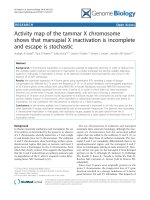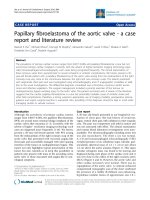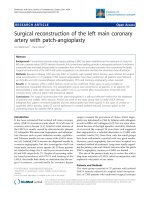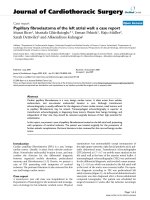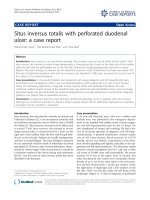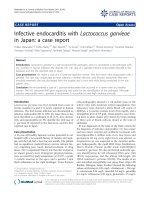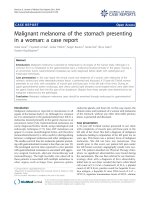Báo cáo y học: "Papillary fibroelastoma of the left atrial wall: a case report" pptx
Bạn đang xem bản rút gọn của tài liệu. Xem và tải ngay bản đầy đủ của tài liệu tại đây (481.47 KB, 4 trang )
BioMed Central
Page 1 of 4
(page number not for citation purposes)
Journal of Cardiothoracic Surgery
Open Access
Case report
Papillary fibroelastoma of the left atrial wall: a case report
Murat Bicer
1
, Mustafa Cikirikcioglu*
1
, Erman Pektok
1
, Hajo Müller
2
,
Sarah Dettwiler
3
and Afksendiyos Kalangos
1
Address:
1
Department of Cardiovascular Surgery, University Hospital and Medical Faculty of Geneva, Geneva, Switzerland,
2
Department of
Cardiology, University Hospital and Medical Faculty of Geneva, Geneva, Switzerland and
3
Department of Clinical Pathology, University Hospital
and Medical Faculty of Geneva, Geneva, Switzerland
Email: Murat Bicer - ; Mustafa Cikirikcioglu* - ; Erman Pektok - ;
Hajo Müller - ; Sarah Dettwiler - ; Afksendiyos Kalangos -
* Corresponding author
Abstract
Cardiac papillary fibroelastoma is a rare, benign cardiac tumor. It often arises from valvular
endocardium, and non-valvular endocardial location is rare. Although transthoracic
echocardiography is usually sufficient for the diagnosis of most cardiac tumors, small tumors such
as papillary fibroelastoma may be missed. Transesophageal echocardiography is superior to
transthoracic echocardiography in diagnosing these tumors. Despite their benign histology, and
independent of their size, they should be resected surgically because of their high potential for
embolization.
In this report, we present a case of papillary fibroelastoma located on the left atrial wall, presenting
with symptoms of cerebral ischemia. The patient was treated surgically for the prevention of
further embolic complications. Pertinent literature is also reviewed for this rare and benign cardiac
tumor.
Introduction
Cardiac papillary fibroelastoma (PFE) is a rare, benign
cardiac tumor. Usually, it arises from valvular endocar-
dium. Nonvalvular endocardial location is rare, and may
confuse the clinician for the differential diagnosis
between organized mobile thrombus, pedinculated
myxoma and fibroelastoma [1-3]. Herein, we present a
case of PFE presenting with symptoms of cerebral
ischemia. The pertinent literature is also reviewed for this
rare and benign cardiac tumor.
Case report
A seventy-two year old man was hospitalized in the
Department of Neurology for the treatment and investiga-
tion of etiology for his ischemic cerebral event. Physical
examination was unremarkable except monoparesis of
the right upper extremity, right fascial paralysis and a pul-
satile abdominal mass. Transthoracic echocardiography
(TTE) showed a 0.7 × 0.7 cm mobile mass attached to the
left atrial wall at the base of the anterior mitral leaflet. A
transesophageal echocardiography (TEE) was performed
for the differential diagnosis, and revealed a mass measur-
ing 1.2 × 0.8 cm, which was attached to the left atrial wall
at the level of the aortic non-coronary leaflet. Pre-opera-
tive diagnosis according to TEE was pedinculated left
atrial myxoma (Figure 1). An infra-renal abdominal aortic
aneurysm was also diagnosed after a thoracoabdominal
computed tomography. The patient was scheduled for
surgical treatment 6 weeks after his ischemic neurologic
event.
Published: 1 July 2009
Journal of Cardiothoracic Surgery 2009, 4:28 doi:10.1186/1749-8090-4-28
Received: 15 December 2008
Accepted: 1 July 2009
This article is available from: />© 2009 Bicer et al; licensee BioMed Central Ltd.
This is an Open Access article distributed under the terms of the Creative Commons Attribution License ( />),
which permits unrestricted use, distribution, and reproduction in any medium, provided the original work is properly cited.
Journal of Cardiothoracic Surgery 2009, 4:28 />Page 2 of 4
(page number not for citation purposes)
The operation was performed under normothermic cardi-
opulmonary bypass using ascending aortic and bicaval
cannulation. After cardiac arrest with antegrade cardiople-
gia, left atrium was opened by extended vertical transatrial
septal (Guiraudon) incision for optimal surgical expo-
sure. A 1-cm, gelatinous and solid looking mass (Figure 2)
was found attached to the left atrial wall near the postero-
medial mitral commisure. It was resected with its stalk,
and the fenestration was directly closed. The resected mass
changed its shape in water to an arboreous, plushy and
sea-anemon like tumor. Per-operative TEE confirmed nor-
mal valvular functions and absence of residual left atrial
mass.
Histologic examination of the resected tumor revealed a
papillary proliferation including few fibroblasts and colla-
genous tissue, covered with endothelial cells (Figure 3).
These morphologic and histologic findings warranted the
diagnosis of PFE. The early postoperative period was
uncomplicated, and the patient was discharged on post-
operative day-10.
Discussion
The incidence of cardiac tumors in autopsy series is esti-
mated at 0.021%, and cardiac PFE constitutes 10% of
these [4]. It is the third most frequent primary cardiac
tumor, after myxoma and fibroma [1-3], and the most
common primary tumor of heart valves. They are often
found on aortic and mitral valves, less frequently on tri-
cuspid and pulmonary valves, and rarely along atrial or
ventricular walls [5-9].
The histogenesis of PFE is still unclear [3,6,8]. There are
several hypotheses about the etiology. They have been
considered as neoplasms, hamartomas, organized
thrombi, and unusual endocardial responses to infection
or hemodynamic trauma [3,8]. Kurup et al. reported that
thoracic irradiation and open cardiac surgery might be the
potential causes for this pathology [3]. On the other hand,
histochemical presence of fibrin, hyaluronic acid, and
laminated elastic fibers supports the hypothesis that PFE
may be related to organizing thrombi [8,10]. A recent
study proposed that it may be related to a chronic form of
viral endocarditis, based on the presence of dendritic cells
and cytomegalovirus in some patients [11].
Pre-operative trans-esophageal echocardiographic image showing small mobile mass attached to the left atrial wall on the level of the aortic valveFigure 1
Pre-operative trans-esophageal echocardiographic
image showing small mobile mass attached to the
left atrial wall on the level of the aortic valve.
Macroscopic images of the resected tumor in and out of waterFigure 2
Macroscopic images of the resected tumor in and out
of water. The anemon-like appearance is classic for papillary
fibroelastomae, which looks like a solid tumor out of water.
Haematoxylin-eosin staining shows hyalinised collagenous matrix encountered by endothelial cellsFigure 3
Haematoxylin-eosin staining shows hyalinised colla-
genous matrix encountered by endothelial cells.
Journal of Cardiothoracic Surgery 2009, 4:28 />Page 3 of 4
(page number not for citation purposes)
The location of PFE in the heart is very important because
of its potential to embolize. Left-sided tumors may cause
stroke, myocardial infarction, mesenteric ischemia, renal
infarction and limb ischemia. Depending on their size
and mobility, PFE can also give rise to obstruction of left
ventricular filling during diastole, resulting in recurrent
pulmonary edema. Right-sided cardiac tumors remain
predominantly asymptomatic until they become large
enough to interfere with intracardiac blood flow, alter
hemodynamic function or induce arrhythmias. These fea-
tures can mimic the clinical picture of tricuspid valve ste-
nosis [8]. Chronic, repeating pulmonary embolization
may lead to significant hypoxemia and severe pulmonary
hypertension [12,13]. Other symptoms are dyspnea, chest
discomfort, and palpitations.
The diagnosis is usually made by echocardiography.
Although TTE is sufficient for the diagnosis of most car-
diac tumors, small tumors such as PFE may be missed, as
evidenced by the present case. TEE is superior to TTE in
diagnosing these tumors [2,9]. Echocardiographic fea-
tures of PFE include; 1. Small lesions, typically less than 1
cm in diameter, but may be as large as 3 to 4 cm; 2. Highly
mobile mass with a pedicle or stalk attached to the valve
or endocardium; and 3. Frond-like appearance [5].
Recently, more cases diagnosed by magnetic resonance
imaging and multislice spiral computed tomography have
been reported [14,15].
There is still a debate for surgical treatment of asympto-
matic patients. Despite their benign histology, surgical
excision is mandated regardless of the size if the patient
has recurrent embolic complications. If the patient has
cerebral embolisation, the operation should be delayed at
least 4 weeks in order to prevent hemorrhagic transforma-
tion of the ischemic infarct. Several atrial incisions might
be used for surgical exposure. We prefer trans-septal or
extended vertical trans-atrial septal (Guiraudon) incisions
for complete resection of left atrial tumors with optimal
exposure, if the patient does not have dilated left atrium.
Differential diagnosis of PFE encompasses other heart
tumors, thrombi, vegetations, valvular calcification and
Lambl's excrescences. Despite its typical shape, imaging
techniques may fail to differentiate PFE from other cardiac
tumors, as evidenced in this case. Histological investiga-
tion after surgical resection is mandatory to confirm the
diagnosis. Cardiac myxoma is a predominant left atrial
tumor, and is usually attached to the atrial septum by a
stalk. Histologically, myxoma differs from PFE by the
presence of polygonal myxoma cells and blood vessels
within the papillae. Cardiac fibroma frequently demon-
strates calcification and cystic degeneration. Cardiac rhab-
domyomae are predominant in infants and children.
Metastic tumors of the heart are more frequent than pri-
mary tumors [4]. Unlike PFE, malignant tumors com-
monly involve the pericardium and myocardium, and are
usually accompanied by systemic symptoms. However,
with both primary and metastatic tumors, the clinical
course may be complicated by emboli.
In conclusion, PFE are histologically benign tumors of the
heart. They have the potential for peripheral or pulmo-
nary embolisation regardless of their size. Since it is usu-
ally small, it cannot be detected reliably by TTE, thus TEE
should be considered for a patient with an unexplained
neurological ischemic event. Although there is a debate
for resection of the asymptomatic PFE, surgical excision is
mandated regardless of the size in order to hinder future
embolic and hemodynamic complications.
Declaration of conflict of interests
The authors declare that they have no competing interests.
Authors' contributions
MB assisted the operation and participated manuscript
writing. MC assisted the operation and participated man-
uscript writing. EP participated manuscript writing. HM
performed echocardiographic examinations. SD made
morphologic and histo-pathologic examination of the
resected tumor. AK is the surgeon and participated manu-
script writing. All authors read and approved the final
manuscript.
Consent section
Written informed consent was obtained from the patient
for publication of this case report and accompanying
images. A copy of the written consent is available for
review by the Editor-in-Chief of this journal.
References
1. Tazelaar HD, Locke TJ, McGregor CGA: Pathology of surgically
excised primary cardiac tumors. Mayo Clin Proc 1992, 67:957-65.
2. Buttany J, Nair V, Ahluwaha MS, El Demellwy D, Siu S, Fiendel C: Pap-
illary fibroelastoma of the interatrial Septum: a case report.
J Card Surg 2004, 19:349-53.
3. Kurup AN, Tazelaar HD, Edwards WD, Purke AP, Virmani R, Klarich
KW, Orszulak TA: Iatrogenic cardiac papillary fibroelastoma:
a study of 12 cases (1990 to 2000). Hum Pathol 2002, 33:1165-9.
4. Reynen K: Frequency of primary tumors of the heart. Am J Car-
diol 1996, 77:107.
5. Eslami-Varzaneh F, Brun EA, Sears-Regan P: An unusual case of
multipapillary fibroelastoma: review of literature. Cardiovasc
Pathol 2003, 12:170-3.
6. Ngaage DL, Mullany CJ, Daly RC, Dearani JA, Edwards WD, Tazelaar
HD, McGregor CG, Orszulak TA, Puga FJ, Schaff HV, Sundt TM 3rd,
Zehr KJ: Surgical treatment of cardiac papillary fibroelas-
toma: a single center experience with eighty-eight patients.
Ann Thorac Surg 2005, 80:1712-8.
7. Klarich KW, Enriquez-Sarano M, Gura GM, Edwards WD, Tajik AJ,
Seward JB: Papillary fibroelastoma: Echocardiographic carec-
teristics for diagnosis and pathologic correlation. Am Coll Car-
diol. 1997, 30(3):784-790.
8. Howard RA, Aldea GS, Shapira OM, Kasznica JM, Dawidoff R: Papil-
lary fibroelastoma: Increasing recognition of a surgical dis-
ease. Ann Thorac Surg 1999, 68:1881-5.
9. Mohammadi S, Martineau A, Voisine P, Dagenais F: Left atrial pap-
illary fibroelastoma: A rare cause of multipl cerebral emboli.
Ann Thorac Surg 2007, 84:1396-7.
Publish with BioMed Central and every
scientist can read your work free of charge
"BioMed Central will be the most significant development for
disseminating the results of biomedical research in our lifetime."
Sir Paul Nurse, Cancer Research UK
Your research papers will be:
available free of charge to the entire biomedical community
peer reviewed and published immediately upon acceptance
cited in PubMed and archived on PubMed Central
yours — you keep the copyright
Submit your manuscript here:
/>BioMedcentral
Journal of Cardiothoracic Surgery 2009, 4:28 />Page 4 of 4
(page number not for citation purposes)
10. Almagro UA, Perry LS, Choi H, Pintar K: Papillary fibroelastoma
of the heart: Report of six cases. Arch Pathol Lab Med 1982,
106:318-21.
11. Grandmougin D, Fayad G, Moukassa D, Decoene C, Abolmaali K,
Bodart JC, Limousin M, Warembourg H: Cardiac valve papillary
fibroelastomas: Clinical, histological and immunohistochem-
ical studies and a physiopathogenic hypothesis. J Heart Valve
Dis 2000, 9:832-41.
12. Gabbieri D, Rossi G, Bavutti L, Corghi F, Zacà F, Sarandria D, Pieran-
geli A, Ghidoni I: Papillary fibroelastoma of the right atrium as
an unusual source of recurrent pulmonary embolism. J Cardi-
ovasc Med (Hagerstown) 2006, 7:373-8.
13. Waltenberger J, Thelin S: Papillary fibroelastoma as an unusual
source of repeated pulmonary embolism. Circulation 1994,
89:2433.
14. Kelle S, Chiribiri A, Meyer R, Fleck E, Nagel E: Papillary fibroelas-
toma of the tricuspid valve seen on magnetic resonance
imaging. Circulation 2008, 117:190-1.
15. Kondruweit M, Schmid M, Strecker T: Papillary fibroelastoma of
mitral valve: appearence in 64-slice spiral computed tomog-
raphy, magnetic resonance imaging, and echocardiography.
Eur Heart J 2008, 29:831.
